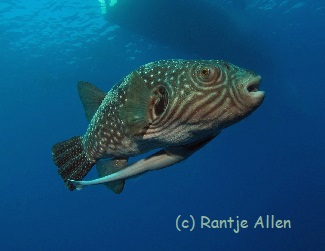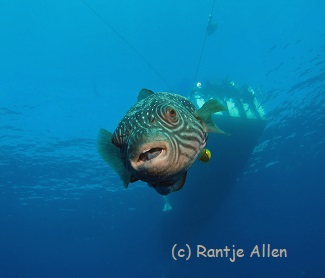Loading content - please wait...
Reticulated puffers delight divers in Gorontalo
Reticulated puffer is a clumsy, clownish swimmer that delights divers who chance to see it. This puffer lives throughout the Indo-Pacific tropics
, including Gorontalo.A Distinctive Network of Lines
The scientific name for this fish is Arothron reticularis, which is a fitting name. Reticulated means arranged like a net or marked like a network. Only the Reticulated puffer has the network of white lines around its face and belly. It sports white spots on its body. But so too does Arothron hispidus
, another puffer species that lacks the network of lines. The body color for Arothron reticularis range from brown to grey.Puffer fish have quite distinctive bodies. This includes tough skin and a dental plate in their beak-like mouth. What they lack is more notable. They lack fin spines and ribs. As a result, they can inflate their stomachs with water when afraid. Moreover, their skin, gonads, and liver contain two toxins. These are tetrodotoxin and saxitoxin. Some species are more toxic than others. Because different puffer species have similar body shapes, identification is most accurate when using color patterns.
So, the reticulated pattern makes the Reticulated puffer easy to identify.
Facing a Reticulated Puffer
Typically, puffer fishes are occasional in the marine environment. However, Miguel’s Diving staff know of one dive site in Gorontalo where Reticulated puffers are likely to be seen. Moreover, this species of puffer fish also exhibits the ability to recognize humans. Certain puffers at that dive site swim right to our dive masters.
The face of a Reticulated puffer makes a delightful photo. Besides showing the distinctive reticulated pattern, the eyes are especially beautiful. Encircled with white rings, the eyes have brown irises and dark pupils. The eyes have great range of motion. This puffer fish smiles for the camera with its four teeth plates. These continually grow. The fish will keep them worn down by eating shrimps and crustaceans. On the snout and between the eyes are twin, forked tuffs. These are actually olfactory organs that allow the fish to smell its watery environment.
Divers will notice that the body of this fish is often sprinkled with sand. During the day, puffer fish often hide in sandy bottoms. They use their pectoral fins to throw sand onto their backs. Their maximum length is 45 centimeters.
Proper Behavior for Divers
Divers should never catch or grab puffer fish to make them inflate. This action frightens the fish
, causing stress. Like many puffer species, the Reticulated puffer is covered with defensive spines. These short prickles are only visible when the fish is puffed up in a defensive posture.Although our Reticulated puffers know some of our dive staff, they do not like to be pursued with cameras. Instead, for guests who want a souvenir photo of this cute fish, we recommend approaching patiently. If the fish starts to swim away, leave it alone. Given time, it will return. A photographer’s random behavior that ignores direct pursuit of the fish will calm it down, allowing a closer approach for a photograph.
For your chance to see this delightful puffer fish in Gorontalo, please make your dive reservations directly with Miguel’s Diving.







